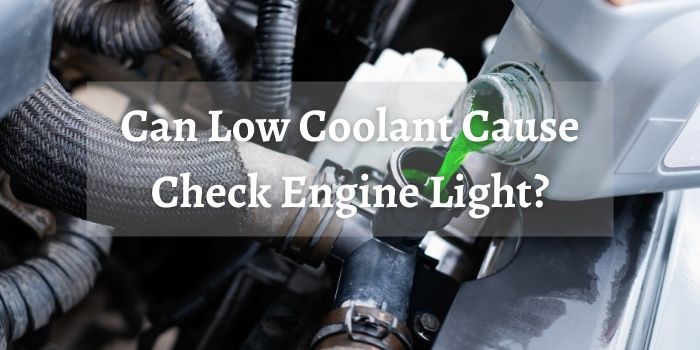Will Low Coolant Cause Check Engine Light

The dreaded Check Engine Light (CEL). It's the automotive equivalent of a cryptic oracle, leaving drivers wondering what gremlins are lurking beneath the hood. While many issues can trigger this illuminated warning, a common question arises: Will low coolant cause a check engine light? The short answer is: It *can*, but it's not always a direct relationship. Let's delve into the nuances.
The Role of Coolant and Engine Temperature
Before we discuss the CEL, let's recap the importance of coolant. Also known as antifreeze, coolant is a vital fluid responsible for regulating engine temperature. It circulates through the engine, absorbing heat and dissipating it through the radiator. Without adequate coolant levels, your engine can overheat, leading to severe damage like a warped cylinder head, blown head gasket, or even a seized engine. Imagine running a marathon in the desert without water – the consequences for your engine are similar.
How Low Coolant Can Trigger a CEL
While there isn't a dedicated "Low Coolant" sensor that directly illuminates the CEL in all vehicles, low coolant can indirectly trigger it through several mechanisms:
- Engine Overheating: The most common scenario. When coolant levels are insufficient, the engine struggles to maintain its optimal operating temperature. The engine's temperature sensor will detect this overheating condition and signal the Engine Control Unit (ECU), which in turn activates the CEL. The diagnostic trouble code (DTC) stored will typically be related to an engine overheating issue, such as P0116 (Engine Coolant Temperature Range/Performance) or P0125 (Insufficient Coolant Temperature for Closed Loop Fuel Control).
- Faulty Coolant Temperature Sensor: Sometimes, low coolant can expose the coolant temperature sensor itself to air. This can cause the sensor to malfunction and send erratic readings to the ECU, resulting in a CEL. Even if the engine isn't technically overheating, the faulty sensor reading can trigger the light.
- Knock Sensor Activation: In some advanced engine management systems, particularly in high-performance vehicles, excessive engine heat caused by low coolant can lead to engine knocking (pre-ignition). The knock sensor, designed to detect abnormal combustion, will pick up these vibrations and trigger the CEL to alert the driver of a potential issue that could damage the engine.
Why *Doesn't* Low Coolant Always Trigger a CEL?
It's important to remember that not all vehicles are created equal. Some older or less sophisticated vehicles may not have the advanced sensors and monitoring systems necessary to detect minor coolant level discrepancies. In these cases, you might only notice the issue through the temperature gauge climbing towards the red zone, or by physically inspecting the coolant reservoir. This underscores the importance of regular visual checks, even if the CEL isn't illuminated.
Diagnosing and Addressing Low Coolant and the CEL
If your CEL is illuminated and you suspect low coolant, the first step is to check the coolant level in the reservoir when the engine is cold. Never open the coolant cap when the engine is hot, as this can result in severe burns. If the level is indeed low, add the appropriate type of coolant (refer to your owner's manual). After topping up the coolant, monitor the temperature gauge and CEL. If the light remains on or the engine continues to overheat, it's crucial to have a professional mechanic diagnose the underlying cause.
Possible causes of coolant loss include:
- Leaks: Check for visible leaks around the radiator, hoses, water pump, and engine block.
- Head Gasket Failure: A blown head gasket can allow coolant to leak into the cylinders or the oil, leading to coolant loss and potentially overheating.
- Faulty Radiator Cap: A malfunctioning radiator cap can prevent the cooling system from maintaining pressure, leading to coolant loss through evaporation.
Ignoring a low coolant situation can lead to costly engine repairs. Regular maintenance, including coolant flushes and inspections for leaks, is essential for maintaining the health and longevity of your vehicle. Remember, a proactive approach to car care can save you significant headaches and expenses down the road. Consider a coolant flush every 30,000 miles or as recommended by your vehicle's manufacturer.
Real-World Examples and Cost Considerations
Consider a scenario involving a 2015 Honda Civic. A common issue for this generation is a slow coolant leak from a slightly corroded radiator. The driver might initially notice the CEL and a slight decrease in fuel economy. A diagnostic scan reveals a P0128 (Coolant Thermostat Below Thermostat Regulating Temperature) code, often related to low coolant affecting the thermostat's operation. Repair costs can range from $300-$600 depending on whether just the radiator needs replacement or if there's collateral damage to other cooling system components. Ignoring this could lead to a blown head gasket, potentially costing upwards of $2000 to repair.
In contrast, a 2008 Toyota Camry might exhibit similar symptoms, but the root cause could be a failing water pump. A leaking water pump gradually depletes the coolant, eventually triggering the CEL. The repair costs are generally similar to a radiator replacement, but neglecting the issue can also lead to timing belt damage in some engines, further escalating repair expenses.
In conclusion, while low coolant might not always directly cause a check engine light, it can indirectly trigger it through overheating or sensor malfunctions. Addressing low coolant promptly is crucial to prevent potentially catastrophic engine damage. Regular maintenance and vigilant monitoring of your vehicle's vital signs are key to a long and trouble-free ownership experience.
